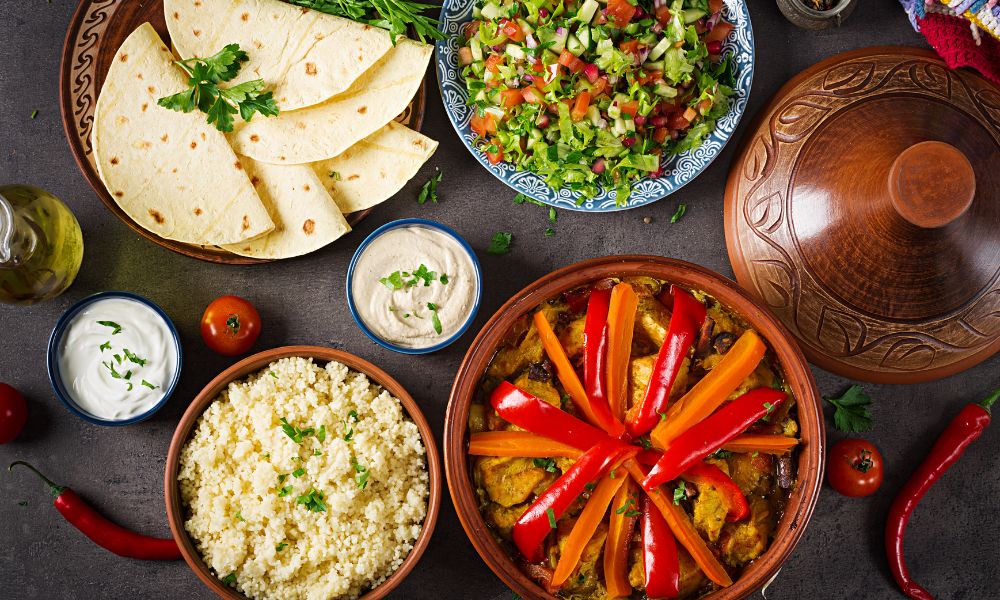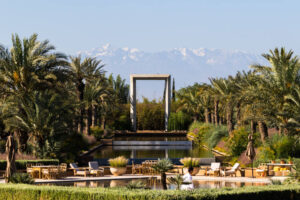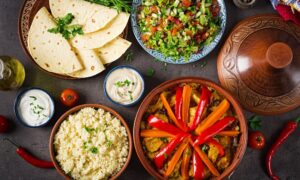Morocco is known worldwide not only for its flourishing history and beautiful architecture but also for its delicious food. It’s home to famous dishes like couscous and tagine. Twelve centuries old, the country has developed a rich culinary heritage. Here, spices smell powerful, and flavor combinations dazzle your senses.
Moroccan food is renowned for its vast array of flavors and cannot be limited to just two or three dishes. Moroccan cuisine features over a hundred dishes, each offering distinct flavors and telling a different story. It’s the cultural diversity that gives Morocco this advantage, as each region of the country has its special food traditions.
If you are a person who favors the idea of experiencing a culture through its food, we promise that you will be amazed by what Moroccan cuisine has to offer.
And for starters, here are the top ten must-try Moroccan dishes.
Bastilla (or B’stilla)
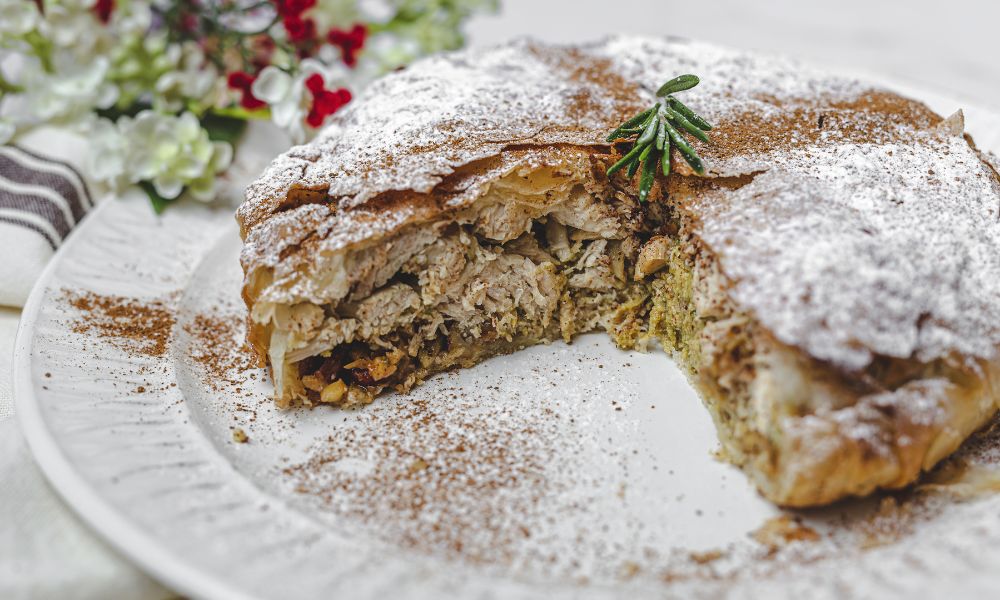
Bastilla is a delicious savory pie that is native to Morocco. It is made using either chicken or seafood and is considered one of the country’s best dishes, if not the best. The word “Bastilla” is derived from “Pastilla” the Spanish word for pastry, as this dish originated in Andalusia, a former Moroccan colony in Spain. This Moroccan delicacy is typically served at special events such as weddings or traditional family gatherings.
In addition to shredded chicken or seafood, some main ingredients used for making Bastilla are a crispy warqa dough (similar to filo dough), Moroccan saffron, crushed almonds, black mushrooms, nutmeg, vermicelli noodles, and seasoned with warm spices. All of these ingredients are layered and wrapped in multiple warqa dough layers, then baked in a round pan until golden brown. To add a final touch, icing sugar, ground cinnamon, or fried almonds are sprinkled over the pie just before serving.
Ingredients differ between Chicken Bastilla and Seafood Bastilla. In terms of flavor, the Chicken Bastilla has a sweet and savory taste. The Seafood Bastilla is made spicy with the use of spicy tomato sauce.
While visiting Morocco, you cannot afford to miss this delectable Moroccan dish. It is a mouth-watering delicacy that is sure to leave you wanting more. We recommend trying it, especially in the two cities of Fes and Marrakech.”
Couscous
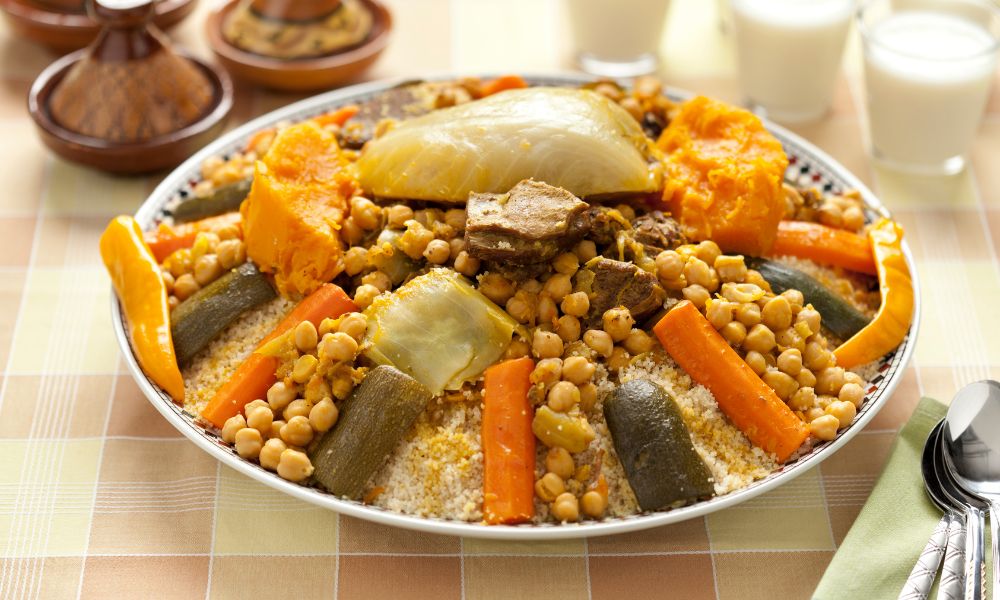
Seksu or kseksu, as called in Morocco, is the country’s national dish and Moroccans’ favorite one. Couscous commonly consists of meat, veggies, and durum wheat semolina. Every Friday, the Muslim holy day, families prepare a large, circular ceramic bowl or plate of couscous that all family members gather around and eat from. It is also served during special occasions and made with love by the family’s head chef, mom, or grandma if still alive.
Making this dish is not an easy process and requires special equipment. To cook both the stew and semolina at the same time, Moroccans use a two-piece metal pot consisting of a base pot for the stew and a top steamer for the semolina. The stew is a mixture of spices, beef or lamb, and seven types of veggies, including carrots, pumpkin, parsnips, cabbage, zucchini, onion, and tomatoes.
On top of the base pot, the semolina is steamed several times, and after each time, it’s laid in a large ceramic bowl and rolled by hand while sprinkled with water, oil, and sometimes flour. The steaming and hand-rolling process makes the small chunks of semolina tender and prevents them from becoming pasty.
When all the cooking is done, the steamed semolina is laid on a circular ceramic plate and shaped almost like a pyramid. After that, the stew from the meat and veggies is evenly ladled on top of the semolina, the meat is placed in the middle, and the veggies are arranged meticulously around it for an aesthetic touch.
Traditionally, Moroccans eat couscous by hand; however, younger generations prefer eating with a spoon. Although they eat from the same plate, they are preservative of their table manners. No matter how delicious the food is, you must eat with your right hand, using your thumb and the next two fingers, and consume only the food in front of you.
By all means, couscous is a one-of-a-kind dish that you can’t miss when visiting Morocco.
Tagine

Tagine is a worldwide famous traditional Moroccan dish. It got its name from the clay pot it’s cooked in. The pot is made up of a circular base and a cone-like shaped lid. Tagine is the second most favorite dish in Morocco after couscous. It’s so popular that you can find it at almost every roadside stop, food stall, or restaurant. And you’re most likely to be served a tagine if you are invited to a Moroccan family house.
A typical tagine dish consists of either lamb, beef, or chicken and veggies, usually potatoes, carrots, onions, and garnished with tomatoes and fresh parsley. In coastal cities, restaurants also serve fish tagines. Tagines are commonly cooked on low fire, allowing all elements to cook slowly over the moisture and steam reflected by the conical clay lid. This method of cooking makes tagines very healthy and exceedingly delicious.
In Moroccan culture, it is customary to eat tagine using small chunks of bread and by hand. However, if you are a foreigner, they will always offer you a fork as an alternative. But for the sake of experiencing the traditional way of eating, it is recommended to try using your hand.
Harira Soup
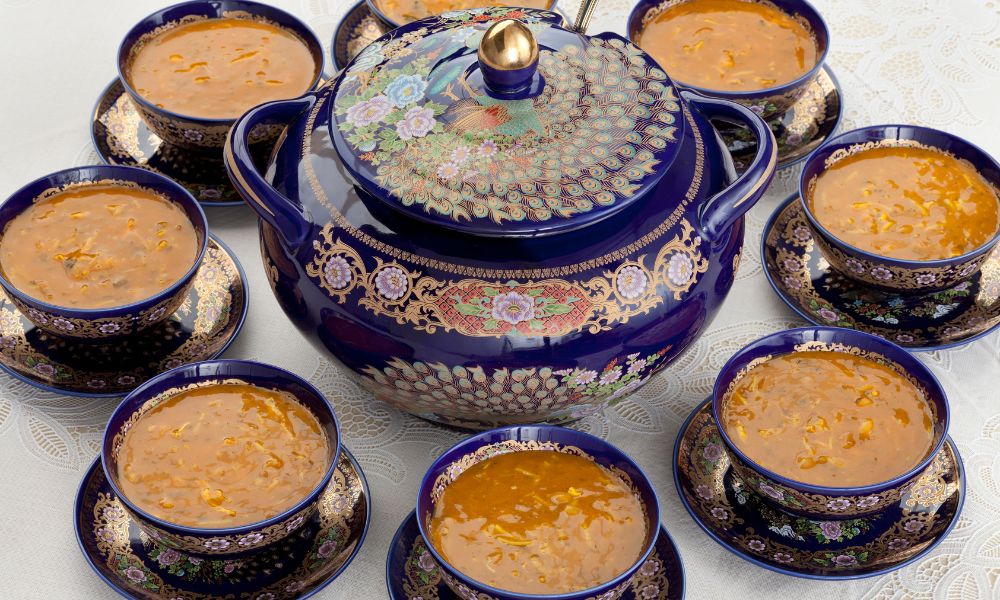
Another must-try Moroccan food is harira, a zesty tomato-based soup with lentils, chickpeas, and celery. Although Moroccans consume it more during Ramadan, harira is served at restaurants at any time of the year. It’s also served every day at food stalls for breakfast or as a late afternoon snack. During special occasions and traditional family gatherings, Moroccans prepare harira as a delicious breakfast meal for their guests.
The name “harira” is derived from the Arabic word “harir,” meaning silk, which refers to the thick and smooth consistency of the soup after it’s cooked. Plenty of nutritious ingredients and fresh herbs are used to make harira, from which we can mention lentils, chickpeas, tomatoes, celery, coriander, parsley, onion, and broken vermicelli. All these ingredients give it a fragrant smell and an irresistible flavor. It is so flavorful that Moroccans consider a Ramadan food table without a big batch of harira as incomplete.
Harira is generally known as a vegetarian soup, but many people would add small chunks of meat to it. However, the vegetarian version is more common. It is typically served with Moroccan bread as a side, but it’s preferably consumed with “Shabakia,” a sweet Moroccan pastry.
Beef with Prunes and Almonds
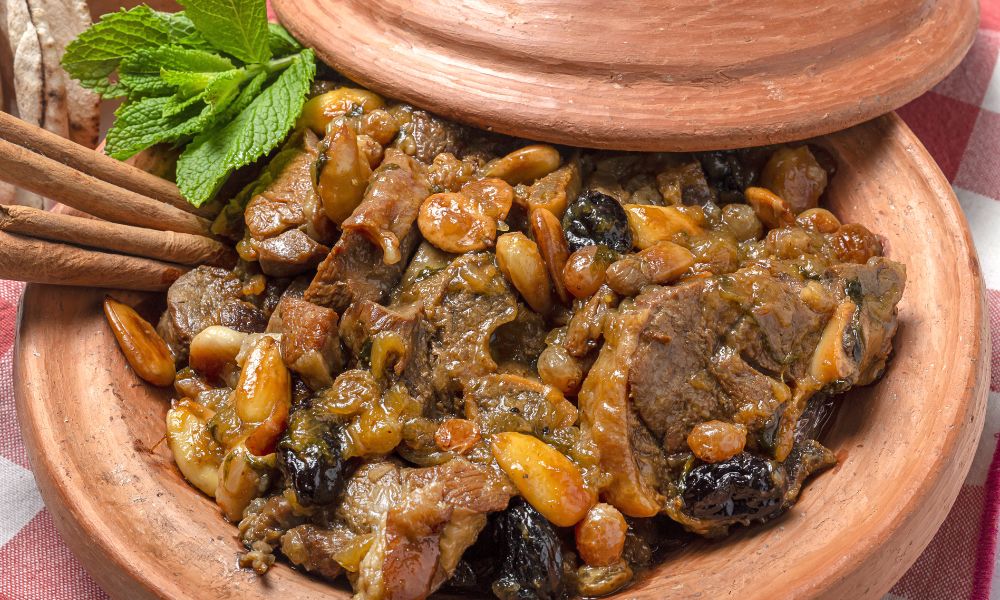
Another renowned dish in Moroccan cuisine is the beef with prunes and almonds. This delicacy is typically served during special events and traditional family gatherings. It’s a staple main course dish at Moroccan weddings, birth celebrations, and funerals. Also, Moroccan families often prepare this dish for their guests. It’s a sweet and savory dish combining a flavorful stew, tender cuts of beef, sweet prunes that melt in your mouth, and crunchy fried almonds.
When cooking for a few people, this dish can be made in a tagine or a small pressure cooker to speed things up. However, when cooking for a special occasion, a large metal pot is used, and after it’s cooked, the dish is served on small plates.
When making this dish, the beef is cooked separately in a stew containing olive oil, onion, garlic, and other herbs and spices such as saffron, ginger, turmeric, and cilantro. Dry prunes are cooked in another pot with cinnamon sticks and honey, and when done, they are sprinkled with toasted sesame seeds. Finally, almonds are blanched with boiling water, peeled, and fried in vegetable oil until golden brown.
Don’t miss this Moroccan culinary masterpiece! Although it is reserved for special occasions in Morocco, it’s still available in restaurants at any time of the year.
Bissara
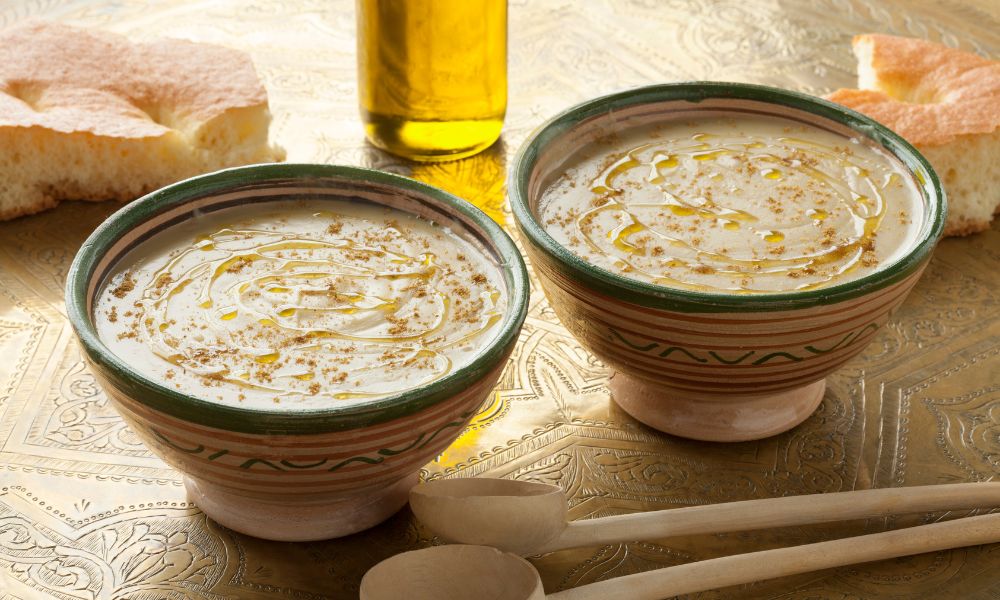
Bissara (or B’ssara) is a famous street food in Morocco. It’s a cheap yet hearty and nutritious soup. It’s a pureed, dried fava beans (broad beans), garlic, cayenne pepper, and olive oil combination. Although bissara is consumed everywhere in Morocco, it is widely popular in the northern part of the country. It is well-known as a nutritious meal as fava beans are rich in fiber, proteins, and vitamins. Moroccans consume bissara more during winter as it provides more energy for the body and keeps it warm.
The main ingredients for this soup are peeled, split, dried fava beans, garlic, paprika, olive oil, cumin, and cayenne pepper. The fava beans are soaked overnight in water and then cooked until tender with garlic, paprika, olive oil, and cumin. When done, the mixture is made into a puree and served in small bowls with olive oil and cayenne pepper sprinkled on top. As a side, Moroccans use bread and sometimes dip the bread in the soup and eat it.
Bissara is another delicious Moroccan soup you must try when visiting the country, especially if you find yourself in cities like Tangier, Tetouan, or Chefchaouen. You can have it as a breakfast meal, a snack, or as a side.
Roasted Chicken with Preserved Lemon and Olives
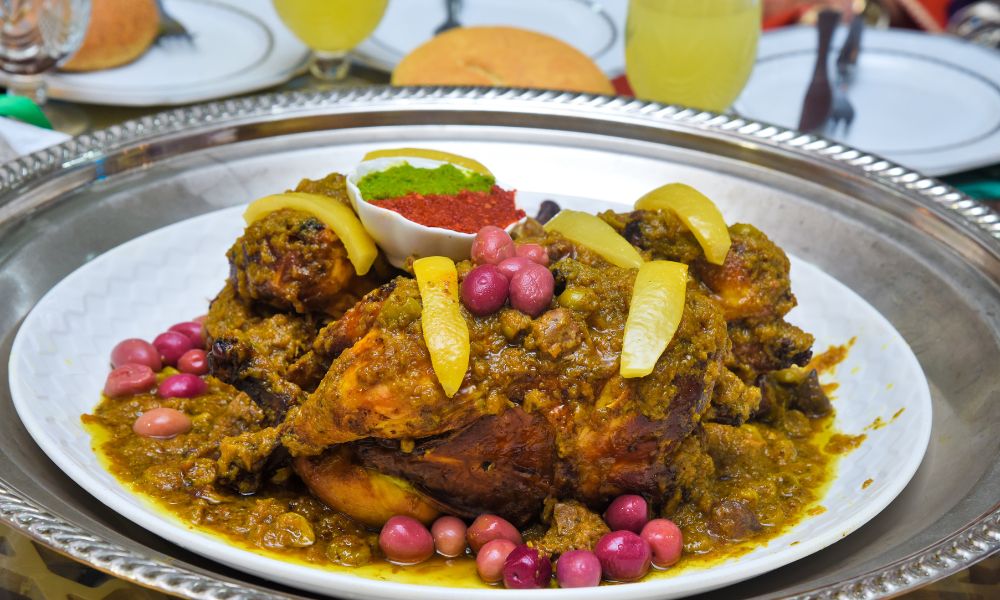
Roasted chicken with preserved lemon and olives is a Moroccan take on a classic worldwide dish. Alongside the beef with prunes and almonds dish, Moroccan roasted chicken is another dish reserved for family gatherings and special occasions. You cannot attend a Moroccan wedding without being served a roasted chicken dish. It’s a flavorful dish combining different herbs and spices with preserved lemons and olives, which gives this dish a spicy, savory, and tangy flavor.
As you have already figured from the title, the main ingredients for this dish are chicken, preserved lemons, and purple olives. However, what makes this dish extra special is its delicious onion sauce. The sauce for this dish, or daghmira as Moroccans would call it, contains onion, garlic, saffron, smen (Moroccan preserved butter), pieces of chicken liver, preserved lemons, purple olives, and many other herbs and spices. This creamy and flavorful topping enhances the taste and makes everybody fall in love with the dish as soon as they have tried it.
To prepare a roasted chicken with preserved lemons and olives dish for a special occasion, Moroccans start at least one day early, as the chicken has to be marinated overnight after being cleaned with lemon, vinegar, and sea salt. For them, thorough poultry cleaning is essential to the taste of the final dish.
The second day, all the chicken is cooked in a large, circular metal pot with onion and spices. The onion-based sauce or daghmira is cooked in a separate pan with small chicken liver pieces, preserved lemon, olives, and various herbs and spices. When almost done, the chicken is briefly roasted in the oven for a beautiful golden color.
After all the cooking and roasting are completed, three whole chickens are placed on a plate and garnished with daghmira, purple olives, and carved preserved lemons filled with hot chili paste. Eventually, the three-chickens plate is served with Moroccan bread to a table of ten lucky individuals.
This dish is available at any Moroccan restaurant at any time of the year. Don’t miss it!
Kefta Tagine

Another Moroccan yummy dish is kefta tagine. It’s a meatball tagine made with a zesty, tomato-based sauce. It’s a delicious dish yet cheap and easy to make. Kefta refers to the ground beef or lamb used in the meatballs. It’s cooked in a tagine pot, which gives it a delectable earthly flavor. However, you can also use a deep skillet to prepare this dish.
The main ingredients for this dish are lamb or beef meatballs, tomato sauce, onion, garlic, fresh parsley, and a variety of spices. After preheating some olive oil in a tagine pot, finely diced onion, tomato sauce, and spices are added. Meatballs are then arranged evenly on top, which allows them to soak up the sauce. Lastly, the tagine is covered and left to cook on low fire. Once the meatballs are done, three to four eggs are cracked on top and cooked for five minutes. And for an aesthetic touch, chopped parsley is sprinkled on top.
When eating it, and for an authentic experience, the meatballs are scooped with small pieces of Moroccan bread and washed down with mint tea.
Kefta tagine is a simple, low-cost dish that will excite your taste buds and leave you wanting more. It is commonly served in Moroccan restaurants and enjoyed by locals and tourists. Don’t forget to order yours when in Morocco!
Shakshuka

Another Moroccan tomato sauce-based dish is shakshuka. This delicious dish is widely popular in all North African and Middle Eastern countries (Arab countries) and is believed to be of Tunisian or Yemeni origins. It’s a simple dish based on tomato sauce and eggs as main ingredients and can be served for breakfast, lunch, or dinner.
Common spices for shakshuka, or “mixture” as the word translates to in English, are ground coriander, paprika, turmeric, cumin, and cayenne pepper. All these spices are added to diced onion, tomatoes, and peppers and cooked until turned into a sauce. Eggs are then cracked on top and simmered until poached. For a final touch, chopped fresh parsley is sprinkled on top.
This savory, mouthwatering dish is simple and takes less than thirty minutes to prepare. Traditionally, shakshuka is served in the same pan in which it is cooked and eaten with small pieces of crispy Moroccan bread.
This dish is another Moroccan delicacy you cannot miss when visiting the country.
Moroccan Lamb or Beef Kebabs (Brochettes)
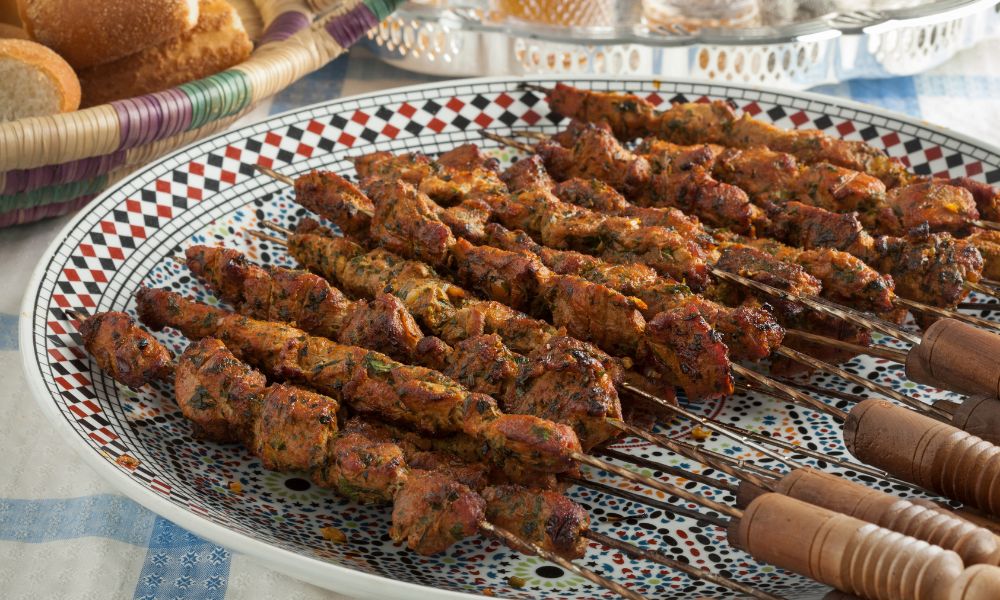
People in Morocco love meat, and what’s a better way to enjoy fine cuts of lamb or beef than to barbecue them over a charcoal grill? In Morocco, the smell of barbecued meat is almost everywhere you go. It’s the street food that every Moroccan desires. It’s their McDonald’s or even better.
Kebabs in Morocco are traditionally made with tender cuts of meat such as leg of lamb or fillet of steak. Although they are consumed at any time of the year, kebabs become more popular during the days following Eid al-Adha.
Before making kebabs, the meat is cut into 3/4-inch cubes and marinated for at least two hours in a spice and herb paste. The paste includes chopped onion and parsley, olive oil, ground black pepper, and lemon juice.
Later, the meat cubes are threaded onto skewers with small pieces of fat in between and then barbecued on a charcoal grill. The use of fat helps keep the meat cubes moist and tender while being grilled. You can add small pieces of pepper to the meat skewers, but it’s optional.
When done, the meat skewers (qotban as Moroccans call them) are sprinkled with ground cumin and salt and served with crispy Moroccan bread, mint tea, and grilled tomato and onion rings. Also, if you are not into lamb or beef, restaurants in Morocco serve chicken and turkey kebabs. Don’t miss ordering yourself some qotban if you find yourself in a Moroccan restaurant!

